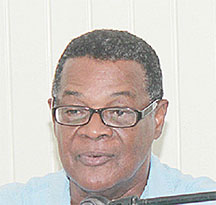The Guyana Gold and Diamond Miners Association (GGDMA) has signaled its intention to strenuously oppose extensions for Amerindian lands and has set up a fund and hired lawyers in anticipation of future court action.
At the GGDMA’s Annual General Meeting on Thursday, President of the GGDMA Patrick Harding said that money from the Low Carbon Development Strategy is being used to fund extensions for Amerindian lands. This was a clear reference to the Amerindian land titling project signed last year. He recalled a meeting with the Inter-American Development Bank where “we walked out” over the issue.
“It’s not fair,” he said while adding that a fund has been set up and the GGDMA has hired lawyers where “we want to challenge these things in court.”

At the miners meeting on Thursday, Chairman of the Guyana Geology and Mines Commission (GGMC) Board of Directors Clinton Williams highlighted the amounts of land made available to miners this year.
Harding said that the politicians are not going to touch the issue because Amerindians are the swing votes. “Nobody wants to talk bad about Amerindians,” he said, while adding that “we have to act on it now.” The GGDMA President said that he has no problems with Amerindians and noted that they are miners too but said that the organisation has to address the land issue.
With the economy over the last five increasingly dependent on the natural resources sector for growth, miners have had a bigger say on public issues. With gold declarations down this year, miners have been pressing the government to open up more and more lands for mining. Several auctions and lotteries of land have been held in recent weeks.
At Thursday’s meeting, former GGDMA Executive Director Edward Shields said that three lawyers have been hired. “We are going to fight the constitutionality of the whole thing,” he said. He spoke of a class action suit and urged any miner who has encountered a problem to come to the GGDMA and “we will proceed.”
The Amerindian Land Titling (ALT) project is funded by payments earned through Guyana’s forest protection partnership with Norway. It is being implemented by the Ministry of Amerindian Affairs and overseen by the United Nations Development Programme (UNDP). Ironically, under the same Norway partnership, Guyana lost US$20M in payments because of deforestation caused mainly by mining.
According to the project summary, the ALT project seeks to enable Amerindians to secure their lands and natural resources with a view towards sustainable social and economic development. It is expected that titling of communities will strengthen land tenure security and the expansion of the asset base of Amerindians, enabling improved long term planning for their future development.
The objective of the project is to facilitate and fast-track the Amerindian Land Titling process. It seeks to have land titles issued and demarcation process completed for all Amerindian villages that submit requests, including those that request extensions, strengthen existing mechanisms to deal with unresolved land issues, improve the communication and outreach efforts of the Ministry of Amerindian Affairs.
According to the project document, the Government of Guyana has set the policy objective of addressing all Land Titling issues by 2015, for Amerindian villages where two thirds of the adult population request this to be done based on the principles of free, prior and informed consent (FPIC). Historically, high costs have been a barrier to achieving this policy objective; however, it is envisioned that with the allocation of funds from the mainly Norway-funded Guyana REDD+ Investment Fund, this objective can finally be realised.
While miners are pressing against further extensions for Amerindian communities, the government is also facing competing demands from indigenous villages. At a meeting last month with Ministry of Amerindian Affairs officials, several Toshaos said they wanted unresolved land issues settled before taking part in the project.
In Chinoweng’s case, its Toshao Davin John told Stabroek News, they wanted their application for land extension to be addressed before demarcation. The village received its land title in 1991. John explained that the village’s titled land is mainly savannah and the majority of the village’s 500 people conduct their traditional activities such as farming outside of the titled land, in the forest. He said that in 2012, they submitted their latest application for an extension of their land but have not received a response to date.
According to John, they were told that the issue of demarcation had to be addressed before extensions are looked at. He, however, said that villagers fear that mining blocks would be handed out to miners before their application for extension is considered and they could end up in a situation like Isseneru, where miners with blocks on the village’s titled land have been allowed to operate on the village’s land without the residents’ consent by virtue of a successful court action. He also noted that several other communities have had their land area reduced after the demarcation exercise.
Last October, on the day after the land titling project was signed, Amerindian leaders protested that the recognition of the use of some of their traditional lands is still to be resolved.




